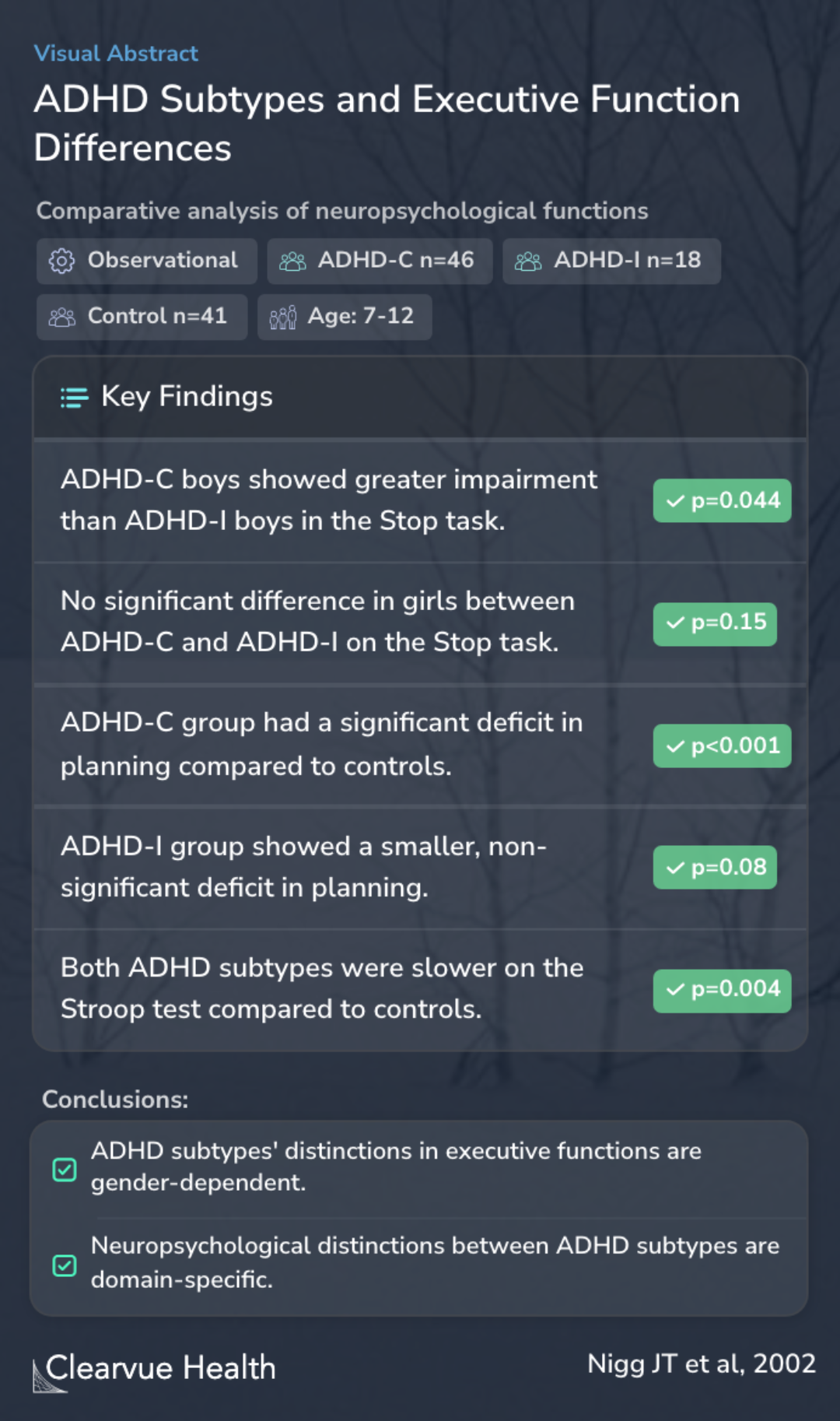Neuropsychological executive functions and DSM-IV ADHD subtypes
ADHD Subtypes and Executive Function Differences
Nigg JT, Blaskey LG, Huang-Pollock CL, Rappley MD

Objectives
The study aimed to evaluate and compare various neuropsychological executive functions between two subtypes of ADHD: the combined subtype (ADHD-C) and the inattentive subtype (ADHD-I). This goal was to understand how these different forms of ADHD affect the brain's executive functions, which are crucial for managing thoughts, actions, and emotions.
To evaluate and compare a focused set of component neuropsychological executive functions in the DSM-IV attention-deficit/hyperactivity disorder combined (ADHD-C) and inattentive (ADHD-I) subtypes.
Methods
To explore these differences, the study used a variety of tasks including the Stop task, Tower of London, Stroop task, Trailmaking Test, and measures of output speed. These tasks were administered to 105 boys and girls aged 7-12, categorized into three groups: ADHD-C (46 children), ADHD-I (18 children), and a control group (41 children).
The Stop task, Tower of London, Stroop task, Trailmaking Test, and output speed measures were completed by 105 boys and girls aged 7-12 classified as either DSM-IV ADHD-C (n = 46), ADHD-I (n = 18), or community control (n = 41).
Results
The results revealed some key differences between the subtypes. Both ADHD-C and ADHD-I subtypes showed deficits in output speed. Interestingly, a gender-specific pattern emerged in the Stop task: boys with ADHD-C had greater impairment than those with ADHD-I, while no significant difference was observed in girls. Additionally, the ADHD-C group showed a significant deficit in planning skills compared to the control group, whereas the ADHD-I group's deficit in planning was smaller and not statistically significant. Both ADHD subtypes were slower on the Stroop test compared to controls.
Both subtypes had deficits on output speed. A group x gender interaction was observed on the Stop task: boys with ADHD-C were impaired versus boys with ADHD-I, whereas girls in the two subtypes did not differ. The ADHD-C type had a deficit in planning. Neither ADHD group had a deficit in...
Conclusions
The study concluded that ADHD-I shares some neuropsychological deficits with ADHD-C, particularly in the domain of output speed. However, the differences between the subtypes are mostly gender-dependent and domain-specific. For instance, in boys, ADHD-C is distinguished by specific deficits in motor inhibition.
ADHD-I shares neuropsychological deficits with ADHD-C in the domain of output speed; on most domains the subtypes did not differ. Neuropsychological distinctions between these ADHD subtypes may be few, depending on which domain of executive functioning is assessed, and these distinctions...
Key Takeaways
Context
This study's findings align with other research, such as a 2010 study by Goth-Owens et al. They found that children with inattentive ADHD (ADD) displayed slower cognitive interference speed compared to ADHD-C and controls, particularly in output speed. This suggests that inattentive ADHD might have unique cognitive challenges.
Moreover, a 2011 study by Nandam et al. explored how medication affects impulsiveness and self-control. They found that Methylphenidate, commonly known as Ritalin, was particularly effective in improving performance and reducing impulsivity on cognitive tasks. This relates to the current study as it underscores the impact of ADHD on cognitive abilities like impulsiveness and attention and how medication might help in managing these challenges.